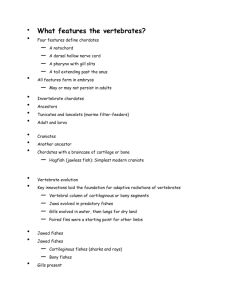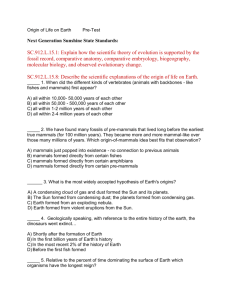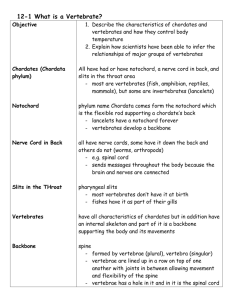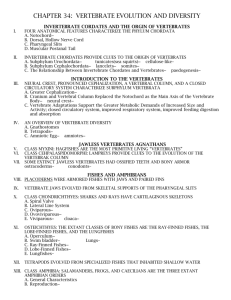topic16 BIOL1030NR
advertisement
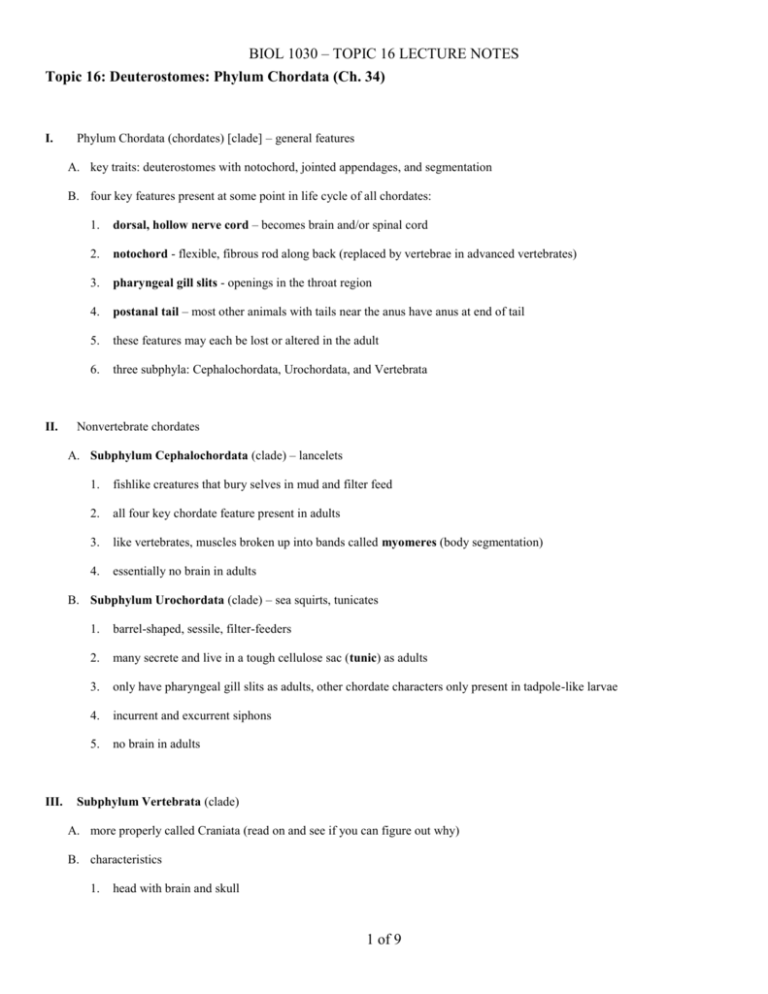
BIOL 1030 – TOPIC 16 LECTURE NOTES Topic 16: Deuterostomes: Phylum Chordata (Ch. 34) I. Phylum Chordata (chordates) [clade] – general features A. key traits: deuterostomes with notochord, jointed appendages, and segmentation B. four key features present at some point in life cycle of all chordates: II. 1. dorsal, hollow nerve cord – becomes brain and/or spinal cord 2. notochord - flexible, fibrous rod along back (replaced by vertebrae in advanced vertebrates) 3. pharyngeal gill slits - openings in the throat region 4. postanal tail – most other animals with tails near the anus have anus at end of tail 5. these features may each be lost or altered in the adult 6. three subphyla: Cephalochordata, Urochordata, and Vertebrata Nonvertebrate chordates A. Subphylum Cephalochordata (clade) – lancelets 1. fishlike creatures that bury selves in mud and filter feed 2. all four key chordate feature present in adults 3. like vertebrates, muscles broken up into bands called myomeres (body segmentation) 4. essentially no brain in adults B. Subphylum Urochordata (clade) – sea squirts, tunicates III. 1. barrel-shaped, sessile, filter-feeders 2. many secrete and live in a tough cellulose sac (tunic) as adults 3. only have pharyngeal gill slits as adults, other chordate characters only present in tadpole-like larvae 4. incurrent and excurrent siphons 5. no brain in adults Subphylum Vertebrata (clade) A. more properly called Craniata (read on and see if you can figure out why) B. characteristics 1. head with brain and skull 1 of 9 BIOL 1030 – TOPIC 16 LECTURE NOTES 2. vertebral column – during development in most (all but Myxini), surrounding and ultimate replacement of notochord by bony or bone-like, hollow vertebrae; also, encase brain in protective box (skull or cranium) of bone or cartilage 3. neural crest ectoderm – a unique set of stem cells that form near neural tube and migrate during development, involved in forming a variety of structures 4. 5. highly developed internal organs unique kidney and excretory system endocrine glands (make many hormones) specialized heart; closed circulatory system endoskeleton made of cartilage and/or bone cartilage and bone are tissues with compacted collagen protein fibers collagen matrix laid down first (provides flexibility) for bone, calcium phosphate is then deposited (provides rigidity) better than chitin – strong but not brittle (if you get enough calcium) C. excellent fossil record - bone makes great fossils; back to over 470 MYA D. living craniates in eight main classes IV. 1. four considered fishes (Myxini, Cephalaspidomorphi, Chondrichthyes, and Osteichthyes) 2. four considered tetrapods (arose from fish; Amphibia, Reptilia, Aves, and Mammalia) 3. follow the evolutionary history as the major groups are covered fishes – paraphyletic assemblage (grade) A. aquatic vertebrates that lack pentadactyl (5-fingered) limbs B. over half of all vertebrates; evolutionarily, the first vertebrates C. characteristics 1. gills – water comes through mouth and goes out throat slits covered with small blood vessels (capillaries); blood flow goes opposite water flow to maximize gas exchange 2. single-loop blood circulation: heartgillsrest of bodyheart D. history of fishes 1. first fishes (now mostly extinct): ostracoderms bony head shields 2 of 9 BIOL 1030 – TOPIC 16 LECTURE NOTES no jaws; filter feeders internal skeletons of cartilage abundant in Ordovician and Silurian Periods (505-408 MYA) perhaps one living group, Class Cephalaspidomorphi, remains jaws evolved from gill arches in some ostracoderms about 410 MYA 2. gnathostomes – jawed vertebrates 3. first successful group of jawed fishes: Class Acanthodii (Acanthodians; extinct clade[?]), or spiny fishes 4. scaly skin with small bony plates up to 7 paired fins with strong spines still had internal skeleton of cartilage common in Devonian Period (408-360 MYA); now extinct members of Class Placodermi (placoderms; extinct clade[?]), or armored fishes, largely replaced the spiny fishes (although spiny fishes may have descended from them!) V. became common during late Devonian extinct by end of Devonian 5. sharks and bony fishes evolved in the Devonian and became dominant by the end of that period 6. Devonian Period called Age of Fishes because of dominance and diversity of fishes in that time Superclass Agnatha (grade) – jawless fishes A. Class Myxini (clade) – hagfishes 1. the hagfishes alive today are of uncertain origin, may not be properly classified 2. temperate oceans 3. cannot regulate body salts 4. slime glands 5. no vertebrae (so, craniates but not really vertebrates) B. Class Cephalaspidomorphi (clade) – lampreys 1. apparently derived from one group of ostracoderms that lost plates 2. vertebrae only shards of cartilage in tail (but are generally considered true vertebrates) 3. larva called ammocoete – filter feeder for many years 3 of 9 BIOL 1030 – TOPIC 16 LECTURE NOTES 4. transform into adult with oral disk with many teeth to attach to other fishes and rasp out body fluid with aid of horny tongue 5. VI. some do not feed as adults: transform, breed, and die Class Chondrichthyes (clade) – cartilaginous fishes; sharks, skates, rays A. may have evolved from a placoderm (or form a clade with placoderms) B. have lost bone and have calcified cartilage instead C. jaw improved over that of placoderms, opens wider D. shark teeth developed from rough scales; as part of skin, are continually replaced E. built better for swimming than placoderms: more streamlined body, better fins F. sharks became dominant predators after the Devonian, have remained as such through today 1. diversity plummeted during the Earth’s largest mass extinction event ~250 MYA 2. number of species has slowly risen since that time; as diverse as ever now (but many are facing extinction due to human influences) 3. myth - sharks are really primitive and the same as what was swimming around hundreds of millions of years ago 4. fact - sharks are incredibly advanced animals that have evolved greatly since their origin approximately 360 MYA G. reproduction 1. internal fertilization - males with claspers used to insert sperm into the uterus of females 2. most species have live birth (a few do lay fertilized eggs) VII. Class Osteichthyes (clade) – bony fishes and their descendants (grade if you leave out tetrapods) A. may have evolved from an acanthodian (or form a clade with acanthodians) B. characteristics of bony fishes 1. 2. swim bladder internal structure filled with air (usually via gases released from blood) amount of air can be adjusted, used to regulate body density and thus depth in water derived from lung, a primitive structure used to breathe air lateral line system found in other jawed fishes, but most prominent in bony fishes system of pores along body 4 of 9 BIOL 1030 – TOPIC 16 LECTURE NOTES 3. used to sense vibrations in water; both moving and still objects can be detected operculum or gill cover allows greater diversity in food capture and preparation increases breathing effectiveness (throat muscles aid in breathing) can breath without swimming, unlike sharks C. Subclass Actinopterygii (clade) – ray-finned fishes 1. most fishes alive today 2. no fin bones or muscle outside of body D. Subclass Sarcopterygii (clade) – lobe finned fishes and their descendants (grade if you leave out tetrapods) 1. coelacanth and lungfishes 2. bone and muscle exit body wall into fins 3. gave rise to tetrapods (four-limbed vertebrates with 5- fingered limbs) VIII. vertebrate invasion of land A. based on genetic evidence, lungfishes are a sister group to the tetrapods B. impetus to get onto land – not food: earliest amphibians were fish-eaters; probably basking (getting heat) or escaping predators C. requirements for successful land invasion by vertebrates: IX. 1. legs (support body weight and allow movement) 2. lungs (gills collapse in air, cannot exchange gases efficiently with air) 3. more efficient heart (more oxygen to walking muscles) 4. prevent eggs from drying out 5. prevent body from drying out Class Amphibia (grade, although modern ones form a clade) – amphibians) A. earliest amphibians - Ichthyostega 1. basically a fish with legs 2. numerous digits on hands, feet 3. tail fin with fibrous rays like a fish 4. 370 MYA, Greenland 5 of 9 BIOL 1030 – TOPIC 16 LECTURE NOTES 5. one of the best transitional series in the fossil record is from fish to amphibian 6. Carboniferous Period (354-290 MYA) – amphibians diversify and are the dominant terrestrial carnivores (Age of Amphibians) B. modern amphibians 1. tend to rely on cutaneous (skin) respiration more than lungs, some without lungs 2. most still require water for early life stages and/or reproduction 3. have 3-chambered heart with pulmonary veins (two-loop system) 4. over 4200 living species in three orders: C. Order Anura – frogs and toads – very derived, lost tail, modified vertebral column for jumping D. Order Urodela (Caudata) – salamanders – elongated body with tail; moist, smooth skin E. Order Apoda (Gymnophiona) – caecilians – lost limbs, look like worms, terrestrial or purely aquatic; burrowing X. Amniotes (clade) – reptiles, birds, mammals, and their relatives A. wonderful transition in fossil record from amphibians B. first appear in fossil record ~350 MYA; dominated Mesozoic Era (251-65 MYA; Age of Reptiles) C. totally adapted to land 1. amniotic egg - egg in a shell to keep from drying (amnion, chorion, yolk sac, and allantois membranes) 2. dry skin 3. covered with keratinized skin - usually in form of scales seals moisture in body thoracic or pulmonary breathing – expand and contract ribcage to get air into lungs, rather than throat; gives much greater capacity to system D. synapsids - pelycosaurs, therapsids; gave rise to mammals 1. share with mammals the synapsid skull one temporal opening on each side (temple), behind the eye orbits jaw muscles anchored to the temple, allows for more powerful bite 2. first amniotes to dominant land were synapsids called pelycosaurs 3. later another group derived from the pelycosaurs, the therapsids, became dominant; pelycosaurs became extinct 4. therapsids gave rise to mammals; therapsids became extinct may have been warm-blooded 6 of 9 BIOL 1030 – TOPIC 16 LECTURE NOTES late therapsids have a derived jaw joint that they share with mammals – another excellent transitional fossil set therapsids and mammals share the cursorial gait – legs tucked under body like pillars; more efficient movement, allows for greater size therapsids and mammals share the heterodont condition – teeth evolved for different purposes, incisors for clipping, canines for piercing, molars and premolars for grinding (almost all other vertebrates are homodont – having the teeth all the same) E. diapsids – diapsid skull (two temporal openings on each side) – most of reptiles, plus birds Class Reptilia (grade) – reptiles (clade if you include Aves) XI. A. paraphyletic assemblage of animals - no uniquely defining characteristics B. all living reptiles are ectothermic (“cold-blooded”- get body heat mainly from external sources); mostly poikilothermic (body temperature fluctuates with ambient temperature) C. some extinct groups were likely endothermic (“warm-blooded” – get body heat mainly from internal sources) and homeothermic (maintain a relatively constant body temperature) D. improved heart to keep oxygen-rich and oxygen-poor blood from mixing (partially or completely 4-chambered) E. 4 living orders and 12 extinct orders; also gave rise to classes Aves (many place Aves within Reptilia) F. Order Chelonia – turtles 1. probably the most primitive group of reptiles 2. little change over past 200 million years 3. no holes in skull for passage of jaw muscles (anapsid skull) G. Order Squamata - lizards, snakes, amphisbaenians - most dominant group alive today (6000 species), skull highly movable H. Order Rhynchocephalia - the tuataras I. 1. two living species native to islands near New Zealand that look like iguanas 2. have a primitive, nonmotile skull 3. group appeared shortly before dinosaurs; branched off of Squamata lineage thecodonts - diapsid protodinosaurs; ectothermic; arose in the Triassic 1. Order Crocodylia – crocodiles, alligators, gavials, caimans derived from thecodont lineage true 4-chambered heart little change over 200 million years 7 of 9 BIOL 1030 – TOPIC 16 LECTURE NOTES 2. dinosaurs also derived from thecodonts some may have been endothermic have cursorial gait (legs tucked under body) dominant in the Jurassic and Cretaceous; died out at end of Cretaceous if you don’t count birds birds – traditionally placed in their own class, Aves, but evolved from dinosaur lineage XII. Class Aves (clade) – birds A. characteristics 1. feathers – derived scales, made of keratin 2. flight skeleton 3. bones tend to be hollow (trait shared with some dinosaurs) backbone fused – increase stability fused collarbones (“wishbone”) keeled sternum – increase area for muscle attachment have 4-chambered heart with pulmonary veins (2-loop system) – required to be endothermic or “warm-blooded” = increased metabolism for flight 4. superefficient respiration – have air sacs that assure that oxygenated air is always going over the lungs 5. lay amniotic eggs (like reptiles) B. derived from Archaeopteryx, a wonderful transitional fossil with many dinosaur and many bird traits (~150 MYA); note this did NOT evolve from pterodactyls C. have been very successful, both in diversification and sheer number, in the Cenozoic Era (the current era); the Cenozoic is sometimes called “the Age of Birds” D. 28 orders and ~10,000 living species; most in Order Passeriformes (songbirds) XIII. Class Mammalia (clade) – mammals A. ~5300 living species B. characteristics 1. hair 8 of 9 BIOL 1030 – TOPIC 16 LECTURE NOTES unique to and defining of mammals long filament of mainly dead skin cells filled with keratin used for many purposes – sensory, insulation, camouflage, coloration, protection 2. mammary glands – milk-producing glands 3. have 4-chambered heart with pulmonary veins (2-loop system), allowing them to be endothermic (“warm-blooded”) and homeothermic 4. heterodont teeth 5. most have a placenta, a specialized organ that serves as an interface between mother and fetus in the womb (each bloodstream kept separate but in close contact; food, water, oxygen, and antibodies given to fetus, while wastes are carried away) C. originated in mid-Triassic ~220 MYA; small, egg-laying, insectivorous creatures, descended from therapsids D. destruction of dinosaurs ~65 MYA left the niches of large animals open, mammals moved into these niches; Cenozoic Era is also called Age of Mammals E. three major living groups, with 19 orders total F. major orders, representatives, relationships, and key characteristics are in your textbook Figure 34.36 – know these G. Order Monotremata (monotremes) 1. examples: duck-billed platypus and spiny echidna 2. lay eggs 3. more primitive skeleton H. Order Marsupialia (marsupials) I. 1. give birth to young which continue development in pouch 2. include opossum, kangaroos, etc. 3. most species are in Australia, New Guinea, and South America eutherians – sometimes called placentals – group of 17 mammal orders; 94% of mammal species 1. most give birth to more precocial young than do marsupials 2. all have a placenta (organ designed to feed young while in womb) however, placentae have evolved numerous times in other animals, including several times in marsupials 3. again, know what it is Figure 34.36 9 of 9
